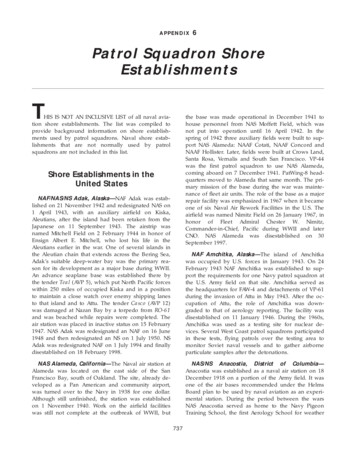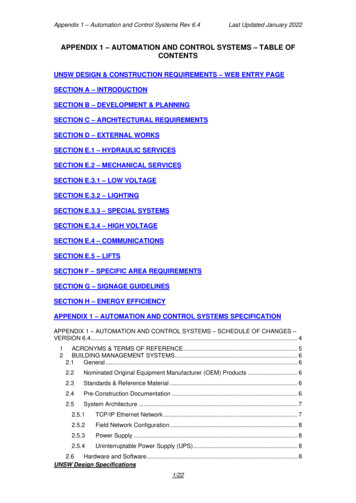
Transcription
DICTIONARY OF AMERICAN NAVAL AVIATION SQUADRONS—Volume IAPPENDIX7376Patrol Squadron ShoreEstablishmentsTHIS IS NOT AN INCLUSIVE LIST of all naval aviation shore establishments. The list was compiled toprovide background information on shore establishments used by patrol squadrons. Naval shore establishments that are not normally used by patrolsquadrons are not included in this list.the base was made operational in December 1941 tohouse personnel from NAS Moffett Field, which wasnot put into operation until 16 April 1942. In thespring of 1942 three auxiliary fields were built to support NAS Alameda: NAAF Cotati, NAAF Concord andNAAF Hollister. Later, fields were built at Crows Land,Santa Rosa, Vernalis and South San Francisco. VP-44was the first patrol squadron to use NAS Alameda,coming aboard on 7 December 1941. PatWing-8 headquarters moved to Alameda that same month. The primary mission of the base during the war was maintenance of fleet air units. The role of the base as a majorrepair facility was emphasized in 1967 when it becameone of six Naval Air Rework Facilities in the U.S. Theairfield was named Nimitz Field on 26 January 1967, inhonor of Fleet Admiral Chester W. Nimitz,Commander-in-Chief, Pacific during WWII and laterCNO. NAS Alameda was disestablished on 30September 1997.Shore Establishments in theUnited StatesNAF/NAS/NS Adak, Alaska—NAF Adak was established on 21 November 1942 and redesignated NAS on1 April 1943, with an auxiliary airfield on Kiska,Aleutians, after the island had been retaken from theJapanese on 11 September 1943. The airstrip wasnamed Mitchell Field on 2 February 1944 in honor ofEnsign Albert E. Mitchell, who lost his life in theAleutians earlier in the war. One of several islands inthe Aleutian chain that extends across the Bering Sea,Adak’s suitable deep-water bay was the primary reason for its development as a major base during WWII.An advance seaplane base was established there bythe tender Teal (AVP 5), which put North Pacific forceswithin 250 miles of occupied Kiska and in a positionto maintain a close watch over enemy shipping lanesto that island and to Attu. The tender Casco (AVP 12)was damaged at Nazan Bay by a torpedo from RO-61and was beached while repairs were completed. Theair station was placed in inactive status on 15 February1947. NAS Adak was redesignated an NAF on 16 June1948 and then redesignated an NS on 1 July 1950. NSAdak was redesignated NAF on 1 July 1994 and finallydisestablished on 18 February 1998.NAF Amchitka, Alaska—The island of Amchitkawas occupied by U.S. forces in January 1943. On 24February 1943 NAF Amchitka was established to support the requirements for one Navy patrol squadron atthe U.S. Army field on that site. Amchitka served asthe headquarters for FAW-4 and detachments of VP-61during the invasion of Attu in May 1943. After the occupation of Attu, the role of Amchitka was downgraded to that of aerology reporting. The facility wasdisestablished on 11 January 1946. During the 1960s,Amchitka was used as a testing site for nuclear devices. Several West Coast patrol squadrons participatedin these tests, flying patrols over the testing area tomonitor Soviet naval vessels and to gather airborneparticulate samples after the detonations.NAS Alameda, California—The Naval air station atAlameda was located on the east side of the SanFrancisco Bay, south of Oakland. The site, already developed as a Pan American and community airport,was turned over to the Navy in 1938 for one dollar.Although still unfinished, the station was establishedon 1 November 1940. Work on the airfield facilitieswas still not complete at the outbreak of WWII, butNAS/NS Anacostia, District of Columbia—Anacostia was established as a naval air station on 18December 1918 on a portion of the Army field. It wasone of the air bases recommended under the HelmsBoard plan to be used by naval aviation as an experimental station. During the period between the warsNAS Anacostia served as home to the Navy PigeonTraining School, the first Aerology School for weather737
738DICTIONARY OF AMERICAN NAVAL AVIATION SQUADRONS—Volume 2forecasting and as a flight test and evaluation center. Anaval reserve air base was established to coexist onthe site. On 26 September 1935, the Army turned overthe entire establishment of the adjacent Bolling Fieldto the Navy, creating more runway space for landbased naval aircraft. During WWII the Navy’s testingand evaluation center was moved from NAS Anacostiato NAS Patuxent River, Md. On 1 July 1946 a Naval AirReserve Training Unit was activated at Anacostia. VP900 was the first reserve patrol squadron (PV-2Harpoons and PBY-5A/6A Catalinas) to makeAnacostia its home port. The reserve components onthe base were relocated to NAF Andrews, Md. NASAnacostia was officially disestablished as an active airstation on 1 January 1962. NS Anacostia currentlyserves as the home for a detachment from HMX-1 thatprovides helicopter transportation for the president.NAAS/NAS Astoria, Oregon—Established on 15December 1940 as NAAS Tongue Point, this facilitywas capable of supporting up to 36 patrol seaplanes.The auxiliary field at Clatsop County Airport supportedNavy landplanes, including PV-1 Venturas. On 31 May1944, Tongue Point, Clatsop Airport and Moon IslandAirport were redesignated NAS Astoria. The facilitywas disestablished on 1 August 1946.NAF Andrews, Andrews AFB, Maryland—(SeeNAF blished as a Naval Reserve Air Base in March 1941,on the site of an Army base (Camp Gordon) unusedsince WWI. The facility, located near Marietta, was redesignated NAS on 1 January 1943. It became a reservenaval air station in 1946, with nine reserve squadronsoperating from there and two at satellite fields atBirmingham, Ala., and Charleston, S.C. Reserve patrolsquadron VP-901 with PBY-5A Catalinas, was established at NAS Atlanta in May 1946. NAS Atlanta was relocated to newly built facilities adjacent to DobbinsAFB, Marietta, Georgia, in April 1959.NAF/NAAF Atka, Aleutians, Alaska—Atka is thelargest of the Andreanof Islands and was establishedas a naval air facility in November 1942. It was redesignated a naval auxiliary air field in February 1943,serving as a refueling site for patrol planes during thecampaign in the Aleutians. The occupation of Kiskasoon made the base superfluous, and it was disestablished on 1 September 1945.NAF Annapolis, Maryland—Annapolis became theearliest site for Naval Aviation when CaptainWashington I. Chambers was detailed on 6 July 1911to the Naval Academy for the purpose of establishinga flying camp. The site he chose was at GreenburyPoint, across the Severn River from the Academy.Flying operations began in September and ended inDecember with the onset of poor flying weather. Thepilots assigned to the U.S. Naval Aviation Camp atGreenbury Point were then transferred to San Diego,Calif., to establish another camp at the Glenn Curtissfacility on North Island. Flying operations resumed atGreenbury Point in the spring of 1912. In the spring of1913, the facility had its first fatality when Ensign W.G. Billingsley was thrown from his aircraft, a B-2Wright hydroaeroplane. The accident led to the development of the seatbelt, which became mandatory forall naval aircraft. Operations ceased at GreenburyPoint on 4 January 1914 when all naval personnelwere relocated to NS Pensacola, Fla., to establish anew flying school for the Navy. A naval air activitywas reestablished at Annapolis in 1926 as a seaplanebase to provide aviation training to Naval Academycadets. The activity was greatly expanded duringWWII and on 20 March 1950 was redesignated a navalair facility. Seaplane training was then relocated toNAS Norfolk, Va. On 1 January 1962, the NAF was disestablished and its assets were relocated to AndrewsAir Force Base, Md., as part of NAF Andrews, whichhad been officially established on 1 January 1962.NAS Atlantic City, New Jersey—The naval air station at Atlantic City was established at the municipalairport in July 1942 and served as a patrol base for 24land planes protecting the convoy approaches to theEast Coast. Several patrol squadrons rotated throughthis facility during the war. Construction of a permanent facility at nearby Egg Harbor was begun inOctober 1942. The new facility was established on 24April 1943, and the old municipal airport, now namedBader Field, was turned over to the Army Air Corps.The principal wartime role of the air station was training fighter squadrons for the fleet. After the war activity decreased only slightly. By 1950 the facility wasdesignated an all-weather station. The first Navy AirReserve squadrons reported aboard on 6 July 1950.Over the next eight years, several reserve patrolsquadrons flew to NAS Atlantic City to perform ACDUTRA training flights. The air station was disestablishedon 1 July 1958 due to increasing civilian air traffic andsuburban buildup around the base.NAAF/NAF Annette Island, Aleutian Islands,Alaska—One of three auxiliary airfields supportingNAS Sitka, Alaska, Annette Island was established on 1March 1943 as an auxiliary airfield and redesignatedNAF on 17 March 1943. NAF Annette Island was disestablished on 16 December 1944.NAF/NAS Attu, Alaska—Attu, the largest of theNear Islands chain in the Aleutians, was occupies bythe Japanese on 7 June 1942. On 28 May 1943,General Yamaziki was invited to surrender via an airdrop from a VP-43 Catalina. He refused and the U.S.Army recaptured Attu on the 29th. NAF Attu was es-
APPENDIX 6739tablished on 8 June 1943 with an auxiliary airfield onthe island of Shemya. When Attu was taken back fromthe Japanese it provided better facilities for seaplaneoperations. VP-45 was the first seaplane squadron toreceive support from NAF Attu via the service provided offshore by the tender Casco (AVP 12). DuringWWII operations from Attu included night bombingand reconnaissance missions to the northern Kuriles,the northernmost of the Japanese home islands. Theairfield was redesignated a naval air station on 17September 1943. It was disestablished on 1 January1949.in honor of Commander John Rodgers for his exploitsin early Naval Aviation. NAS Barbers Point was disestablished on 1 July 1999.NAS Banana River, Florida—This facility was established as a secondary seaplane base for NASJacksonville, Fla., on 1 October 1940. The base servedas a PBM Mariner training and ASW patrol site duringWWII and was inactivated on 1 August 1947 and disestablished on 1 October 1947. On 1 July 1951, thesite was turned over to the U.S. Air Force for use asthe USAF Eastern Space and Missile Center.NAS/MCAAS/MCAS Beaufort, North Carolina—The last of 23 naval air stations begun during thenaval construction program of 1942. Facilities includedbarracks for 2,800 men, four nose hangars, one fullhangar, storehouses and fuel storage for 350,000 gallons of aviation gas, and four 6,000-foot asphalt runways. Established as a NAS on 15 June 1943, redesignated MCAAS on 26 June 1956 and then redesignatedMCAS on 1 March 1960.NAAF/NAAS Bar Harbor, Maine—(see NASBrunswick, Maine) This base was originally established on 1 September 1943 as an NAAF secondaryfield to NAS Brunswick, Maine. It was redesignated anNAAS on 22 August 1945 and was disestablished on 15November 1945.NAS Barbers Point, Oahu, Hawaii—Barbers Pointwas first surveyed by the Navy in July 1940 and established as a naval air station on 15 April 1942. NASBarbers Point was utilized for advanced combat training for fighter and bomber crews prior to assignmentto forward areas. The base was home to CASU-2,which overhauled engines and aircraft for the fleet. Bythe end of WWII the facility had grown to a force ofover 4,000 officers and men. Postwar budget cuts reduced the on-board complement to 378 officers andmen, and the future of the base seemed uncertain. In1949 the naval air activities in Hawaii were consolidated at Barbers Point. The first half of 1950 saw thearrival of the first patrol squadron, VP-6, from NASWhidbey Island, Wash. During the Korean conflict,NAS Barbers Point once again assumed a wartime roletraining aircrews for combat. It also served as a basefor supplying UN forces with cargo and replacementpersonnel. The post-Korean War period saw a continued increase in the scope of activities and constructionof facilities at NAS Barbers Point. When CommanderFleet Air Hawaii moved its headquarters to BarbersPoint in 1959, Fleet Air Wing 2 came aboard as well.This provided the air station with a new role of supporting operational and training missions in the VPcommunity. In June 1973, Commander Fleet AirHawaii was disestablished and the air station beganreporting to Commander Naval Air Pacific. The airstripwas named John Rodgers Field on 10 September 1974,NAAS Barin Field, Florida—One of six auxiliary airstations serving NAS Pensacola, NAAS Barin Field wasestablished for intermediate training on 5 December1942 and disestablished on 15 March 1947. The facilitywas reestablished as NAAS Barin Field on 15 January1952 for basic and advanced training. It was placed inan inactive status on 31 October 1958 and is currentlyused as an OLF for Whiting Field.NAS/NARF Birmingham, Alabama—(see NASAtlanta, Ga.) This airfield was built as an adjunct tothe civilian airport at Birmingham, Ala., and was established as a naval air station on 15 September 1948 andserved as a secondary reserve training base for NASAtlanta. It was redesignated a naval air rework facilityon 25 June 1956. The NARF was in turn disestablishedon 1 October 1957 when the facilities were sold to acivilian firm that continued running the air rework facility under government contract.NAAF/NAAS/NAS Boca Chica, Florida—BocaChica was established as an NAAF on 1 April 1943. Itwas redesignated an NAAS on 23 October 1943 andbecame an NAS on 8 February 1945. During the warthe base was used by patrol squadrons for advancedtraining in ASW off the coast of Florida. With the endof WWII, vast cutbacks in military spending ensuedand many bases, including Boca Chica, were closed.NAS Boca Chica was officially disestablished on 31March 1945.NAAS Bronson Field, Florida—One of six auxiliaryair stations serving NAS Pensacola, Fla., NAASBronson Field was established for training on 18November 1942 and disestablished on 15 March 1947.After disestablishment it became an OLF for NASPensacola.NAAS Brown Field, Otay Mesa, California—Brown Field was established as a naval auxiliary airstation on 17 March 1943 for NAS Camp Kearney (laterrenamed NAS Miramar). It was named in honor ofCommander Melvin S. Brown, who was killed in aplane crash in 1936. Commander Brown participatedin the first trans-Atlantic flight of the NC flying boats in
740DICTIONARY OF AMERICAN NAVAL AVIATION SQUADRONS—Volume 21919. During WWII the field was used to train air unitsand patrol squadrons preparing for duty in the Pacific.On 1 June 1946 the field was put in a caretaker status.With the increase in Naval Aviation activity broughtabout by the Korean War, Brown Field was restored tolife once again as an ALF for NAS San Diego, Calif., on1 November 1951. The ALF was redesignated NAASBrown Field on 1 July 1954. On 2 November 1954, theConvair XFY-1 Pogo made its first historic verticaltakeoff and landing at NAAS Brown Field. During thisperiod the field was home to one utility squadron, aRegulus air missile detachment, two antisubmarinesquadrons and one fleet aircraft service squadron detachment. On 1 July 1961, the field reverted to an ALF,with minimal staff on board. On 1 September 1962 thefield was disestablished and custody given to the Cityof San Diego.NAS Brunswick, Georgia—This base was one ofthe sites recommended under the Helms Board plan tobe used by Naval Aviation as a patrol air station. By 13November 1918 the construction was complete andpersonnel assigned, but with no assigned seaplanes.By 20 May 1919 the base was listed as being in a nonoperating status. It was officially disestablished 12October 1920. (see NAS Glynco, Georgia for WWII period)NAS/NAF Brunswick, Maine—This base was established as a naval air station on 15 April 1943 to trainRoyal Canadian Air Force pilots and was disestablished on 15 December 1946. Five auxiliary landingfields in Maine had been attached to NAS Brunswick:Bar Harbor, Lewiston, Sanford, Rockland and CascoBay. Brunswick was reactivated as an NAF on 15March 1951 to serve as the home for Fleet Air Wing 3.Records indicate it was scheduled for redesignation toan NAS on 15 September 1951. Brunswick has remained an active naval air station since 1951.NAAS Camp Kearny, California—During WWI theU.S. government purchased the Kearny Ranch located13 miles north of San Diego, Calif. The Army established Camp Kearny as a military training base forlighter-than-air craft and also as an aircraft targetbombing range. With the outbreak of WWII, thesouthern portion of the base was given to the Navyfor use as an auxiliary airfield for NAS San Diego,Calif. Officially established as an NAAS on 20 February1943, this facility served as a major training and staging area for patrol squadrons preparing for thetranspac to WestPac and the South Pacific combatzone. The Army relinquished its control of the northern portion of Camp Kearney, and both sections of thebase were consolidated on 1 May 1946 and redesignated Marine Corps Air Station Miramar. It reverted toNavy control on 30 June 1947 and was redesignatedNAAF. On 1 April 1952 the facility was redesignatedNAS Miramar. On 14 June 1955, the airfield wasnamed Mitscher Field in honor of Admiral Marc A.Mitscher, Naval Aviator No. 33, leader of fast carriertask forces in WWII and Deputy CNO (Air). The airstation reverted for a second time to Marine Corpscontrol and was redesignated MCAS Miramar on 1October 1997.NAS Cape May, New Jersey—This facility was oneof the air bases recommended under the Helms Boardplan to be used by Naval Aviation as a patrol air station. It was established as an NAS on 6 October 1917,but not turned over to the Navy until 4 December1917. During WWI 12 seaplanes and 1 dirigible wereassigned to the station. The Cape May station remained Navy property after the war until 1926 whenthe seaplane hangar and several of the buildings weretransferred to the Coast Guard. On 16 September 1940the base was reestablished as a naval air station tosupport two carrier squadrons. The old WWI dirigiblehangar was torn down and an eight-spoke airfieldwith taxiways was built. On 1 May 1946 the airfieldwas reduced to caretaker status. The facility was disestablished on 1 June 1946 and turned over for the second time to the Coast Guard, which has continued touse it through the 1990s.NAAF/NAAS Casco Bay, Maine—(see NASBrunswick, Maine) This facility was established as anNAAF secondary seaplane base for NAS Brunswick on14 May 1943. It was designated an NAAS on 22 August1945, put in caretaker status on 15 May 1946, and officially disestablished on 15 December 1946.NAAS/NAS Cecil Field, Florida—(see NASJacksonville, Fla.) Cecil Field was established as anNAAS for NAS Jacksonville on 20 February 1943. Itwas named for Commander Henry B. Cecil, NavalAviator No. 42, lost in the crash of the dirigible Akron(ZRS-4) on 4 April 1933. NAAS Cecil Field was disestablished on 1 March 1948 and reactivated on 1November 1948. It was redesignated an NAS on 30June 1952. Due to budget cutbacks and base closures,NAS Cecil Field was closed in 1999.NAS Charleston, South Carolina—(see NASAtlanta, Ga.) This was one of the air bases recommended under the Helms Board plan to be used byNaval Aviation as a kite balloon station. It was underconstruction during WWI but not completed beforethe war came to an end. During WWII the base wasestablished as an NAS secondary to NAS Atlanta, Ga.,on 15 June 1942. It was disestablished on 1 August1946.NAS Chatham, Chatham Port, Massachusetts—This was one of the air bases recommend under theHelm Board plan to be used by Naval Aviation as a
APPENDIX 6patrol station. The contract for construction of thebase was let on 8 September 1917, but NAS Chathamwas not completed until late March 1918. Twelve seaplanes and one dirigible conducted patrols over thesea lanes from this base. By 20 May 1919, the basewas listed as being in a nonoperational status.NRAB/NAS Chicago, Illinois—(see NAS Chincoteague was established on 5 March 1942 atChincoteague Island, Va., to serve as an outlying fieldfor the housing, maintenance and training of carrierfighter squadrons assigned to NAS Hampton Roads,Va. By 1944 the facility was used to provide operational training to PB4Y-2 Privateer crews. It was redesignated an NAS on 1 January 1950 and used as a navalaviation ordnance test station. On 1 July 1951 the basewas redesignated an NAAS and on 1 January 1955 redesignated an NAS. VP-8 was based there from April1958 until the station was closed in 1959. The facilitywas disestablished on 30 June 1959 and transferred toNASA to supplement their operations at nearbyWallops Island.NAS Clinton, Oklahoma—This facility was established under the Special Task Air Group training command as an NAS on 1 June 1943. The flat, open spacessurrounding the base made secrecy of special test projects easier to maintain. VBs 152 and 153 were established in August 1943 and April 1944, respectively, andlocated at NAS Clinton, to test the target seeking glidebomb known as Pelican. The Pelican was equippedwith a beam-rider radar homing device developed bythe Bureau of Ordnance Special Design Section inApril 1942. After a number of tests in early 1944, withonly limited success, the project was cancelled in lateJuly 1944. Numerous other special projects were alsotested there during the war. With the end of hostilitiesthe base was placed in caretaker status by December1945 and formally disestablished on 1 June 1946.NAAF Cold Bay, Alaska—(see NAS Kodiak, Alaska)This small facility, located on Shumagin Island, servedas a refueling stop and temporary base for seaplanesoperating as detachments from Dutch Harbor. The bayon Shumagin Island had been in use by the Navy asan anchorage since 1929. After the Japanese invadedthe Aleutians in June 1942, the Cold Bay site was established as a naval section base in July 1942. It wasredesignated an NAAF on 5 September 1942, and wasdisestablished on 7 November 1944, after the withdrawal of Japanese forces from the Aleutians.NAAS Corry Field, Florida—One of six auxiliary airstations serving NAS Pensacola, Fla., Corry Field wasestablished as an NAAS on 15 January 1943 for use in741primary training and disestablished on 20 March 1946.The station was reestablished as an NAAS for basictraining on 11 August 1948 and disestablished on 30June 1958.NAAS/NAAF Crows Landing, California—This sitewas established on 25 May 1943 to serve as an auxiliary airfield for PB4Y-1 and 2 squadrons operating outof NAS Alameda, Calif. It was also used by bombercrews as a glide bombing and air-to-ground gunneryrange. The station was inactivated on 1 July 1946, butcontinued to serve as an auxiliary and emergencylanding field for NAS Moffett Field, Calif., until closureof that facility in 1994.NAS Deland, Florida—NAS Deland was establishedas a primary training base on 17 November 1942. Italso served as an advanced training site for patrolbombers conducting operational ASW patrols off thecoast of Florida. The facility reverted to caretaker status on 15 April 1946 and was disestablished on 15June 1946.NAF Detroit, Michigan—NAF Detroit was established on 8 November 1969 following the closure ofNAS Grosse Ile, Mich. The latter facility was too smallfor the reserve’s transition to jet aircraft and larger patrol planes. The new base became a tenant commandat Selfridge Air National Guard Base, Mount Clemens,Mich. The relocation of reserve patrol squadrons toNAF Detroit, Selfridge Field, marked a return of navalreserve aviation, originally based there from 1927 to1929. NAF Detroit became home to the VP-93Executioners on 1 July 1976. Facilities were sharedwith Army, Air Force, Coast Guard and Marine Corpsreserve units. Patrol squadron operations ceased atNAF Detroit with the disestablishment of VP-93 on 30September 1994.NAS/NAF Dutch Harbor, Aleutians—Situated onUnalaska, an island in the Aleutians purchased fromRussia in 1867, Dutch Harbor was the second locationin the Aleutians the U.S. had once started to fortify.The first fortifications began on Kiska in 1916 but wasabandoned shortly thereafter and never completeddue to the Washington Conference of 1921–1922, inwhich the U.S. agreed not to fortify the Aleutians.Construction of air facilities at Dutch Harbor was commenced in 1940, not as a bastion against Japanese aggression, but against potential Russian incursions. Thebase was established as an NAS on 24 June 1941. On 4June 1942, the Japanese forces made their move onthe island chain, landing first on Kiska, 700 miles fromNAS Dutch Harbor. Attu, at the tail end of the Aleutianchain, was also occupied at that time. Dutch Harborserved briefly as FAW-4 headquarters from July toAugust 1942. On 1 July 1944, the air station was redesignated an NAF, and serviced nearly all of the patrol
742DICTIONARY OF AMERICAN NAVAL AVIATION SQUADRONS—Volume 2squadrons operating in the theater until the conclusionof WWII. The facility was officially disestablished on 1November 1947.NAS/MCAS Eagle Mountain Lake, Texas—TheMarine Corps established an air station at EagleMountain Lake on 13 July 1942 as a training facilityfor Marine Corps aviators. On 1 July 1943, the Navyredesignated the facility an NAS under the TrainingTask Force Command. The station was used as atraining facility and to provide support for seaplanesquadrons conducting transcontinental flights.Nearby NAAF Rhome Field, Rhome, Texas, served asthe auxiliary airfield for NAS Eagle Mountain Lake.The bases supported one combat wing and stationpersonnel, totaling 141 officers, 1,003 enlisted personnel and 75 aircraft. The air station was a convenient halfway stopping point for Navy seaplanes, affording refueling and maintenance facilities fortransiting aircraft. On 31 March 1944, the station wasreturned to the Marine Corps along with RhomeField, and redesignated an MCAS. The station supported 54 fighter and dive bombing aircraft andRhome Field supported an additional 18 aircraft. On1 April 1946 MCAS Eagle Mountain Lake was reduced to caretaker status and disestablished on 15December 1946.NAS/MCAS/NAAS Edenton, North Carolina—SecNav established NAS Edenton on 13 July 1942 as atraining facility under the Commandant, Naval AirOperational Training Command. It was transferred tothe Marine Corps on 9 July 1943 and redesignatedMCAS Edenton. The base served as a glider trainingcenter and later as a two-engine landplane training sitewith 36 PV-1 Venturas and 18 SNB-1 Kansans. On 1March 1945 the station was returned to the Navy andredesignated NAS Edenton. With the end of WWII andsubsequent base closures, the station was inactivatedon 1 August 1946. It was reactivated as an ALF forMCAS Cherry Point, N.C., on 14 January 1952. On 2August 1955 it returned to Navy control as an NAAS,remaining under the military command of MCASCherry Point. The facility was officially disestablishedon 31 December 1958. On 9 January 1959, the fieldwas redesignated an OLF for MCAS Cherry Point.NAS Elizabeth City, North Carolina—Originallyconstructed as a Coast Guard air station at a site selected in 1938 on the banks of Davis Bay off thePasquotank River, the station was taken over by theNavy and established as an NAS on 6 March 1943. Thenorth end of the station was enlarged by the additionof over 100 buildings needed for crew training on thePV-1 Ventura, PBY Catalina, PBM Mariner and FreeFrench SBD dive-bomber squadrons. The facilityserved as the central base for the Eastern Sea FrontierCommand. It operated the largest search and rescueunit on the East Coast with 55 aircraft available forduty in a special rescue squadron. The station returned to Coast Guard control on 15 March 1946 andwas officially disestablished as an NAS on 15 June1946.NAAS/NAS Ellyson Field, Florida—Ellyson Fieldwas one of six auxiliary air stations serving NASPensacola, Fla. It was established on 1 October 1941as an ALF and operated as such until 20 January 1943when it was redesignated an NAAS and used for primary training. The station went into caretaker statuson 15 January 1946 and was inactivated on 15 March1947. It was reactivated as an ALF on 3 December1950 to serve as a helicopter training facility. ALFEllyson Field was redesignated an NAAS on 1November 1967 and then became an NAS on 31 July1968. NAS Ellyson Field was disestablished on 31December 1973.NAAF Fleming Field, Minnesota—(see NASMinneapolis, Minn.) Fleming Field was established asan NAAF for NAS Minneapolis on 20 July 1943. TheNAAF was named in honor of Captain Richard E.Fleming, USMC, killed while leading an attack on anenemy cruiser in the Battle of Midway.Disestablishment date is uncertain, but it is believed tobe in the 1946 time frame.NRAB Floyd Bennett Field, New York—When the decision was made in 1928 to develop amunicipal airport for New York City, Barren Island, located in Jamaica Bay on the southern tip of Brooklyn,was selected for the site. The new field was named forits native son Warrant Officer Floyd Bennett, Medal ofHonor recipient and companion of LieutenantCommander Richard E. Byrd (later Admiral) during hisflight over the North Pole in 1926. The field was dedicated by the city on 23 May 1931, with facilities forboth landplanes and seaplanes. From 1931 to 1941 thefield served as the takeoff point for many recordbreaking flight attempts, including flights by WileyPost, Howard Hughes, Amelia Earhart, Roscoe Turner,Laura Ingalls, Jimmy Doolittle, Jacqueline Cochran andDouglas “Wrongway” Corrigan. A portion of the newfacility was established as an NRAB on 11 June 1931.On 23 April 1938 Floyd Bennett Field also became t
to the Navy, creating more runway space for land-based naval aircraft. During WWII the Navy's testing and evaluation center was moved from NAS Anacostia to NAS Patuxent River, Md. On 1 July 1946 a Naval Air Reserve Training Unit was activated at Anacostia. VP-900 was the first reserve patrol squadron (PV-2 Harpoons and PBY-5A/6A Catalinas .










